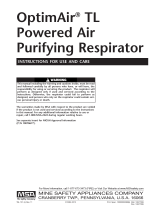
Head Protection
When assembled and used according to these User Instructions, the 3M helmet assemblies meet the
requirements of ANSI Z89.1-2003 Type I, Class E head protection. This helmet helps provide limited
head protection against impact and penetration and contact with electrical conductors.
Glossary of Terms
APF—Assigned Protection Factor. The expected level of respiratory protection that would be provided
in the workplace by a properly functioning respirator to properly fitted and trained
users. Always expressed as a multiple of the permissible exposure limit (“PEL”) for the
contaminant from which you are seeking protection.
PEL—Permissible Exposure Limit. The maximum allowable concentration of a contaminant in the air
to which an individual may be exposed. These may be time-weighted averages, short-term
limits, or ceiling limits.
Abrasive blasting respirator—a respirator designed to help protect the wearer from inhalation of,
impact of, and abrasion by materials used or generated in abrasive blasting.
Airline respirator—an atmosphere-supplying respirator in which the breathing air is not designed to be
carried by the wearer (also called a type “C” supplied air respirator ).
Breathing air—respirable air that meets at least the specification for Grade D breathing air, as
described in the Compressed Gas Association Commodity Specification G-7.1-1997 in the
United States. In Canada, refer to CSA standard Z180.1, table for the quality of compressed
breathing air.
Continuous flow respirator—an atmosphere supplying respirator which provides a continuous flow of
breathing air to the respiratory inlet covering.
Helmet—a respiratory inlet covering which completely covers the head and neck and portions of the
shoulders and which offers head protection against impact and penetration.
Immediately dangerous to life or health (IDLH)—any atmosphere which poses an immediate hazard to
life or poses immediate, irreversible debilitating effects on health.
Respiratory inlet covering—that portion of a respirator that connects the wearer’s respiratory tract to
an air-purifying device or breathing air source, or both.
Type “C” supplied-air respirator—an airline respirator for entry into and escape from atmospheres not
immediately dangerous to life or health (“IDLH”) which consists of a source of respirable
breathing air, a hose, a detachable coupling, a control valve, orifice, a demand valve,
or pressure demand valve, an arrangement for attaching the hose to the wearer, and a
facepiece, hood or helmet.
Type “CE” supplied-air respirator—a type “C” supplied air respirator equipped with additional
devices designed to protect the wearer’s head and neck against impact and abrasion from
rebounding abrasive material, and with shielding material such as plastic, glass, woven
wire, sheet metal, or other suitable material to protect the window(s) of facepieces, hoods,
and helmets which do not unduly interfere with the wearer’s vision and permit easy access
to the external surface of such window(s) for cleaning.
Assigned Protection Factor
3M supports an assigned protection factor (APF) of 1,000 for this helmet, which is consistent with
the OSHA APFs defined in 29 CFR 1910.134. According to OSHA, “The employer must have evidence
provided by the respirator manufacturer that testing of these respirators demonstrates performance
at a level of protection of 1,000 or greater to receive an APF of 1,000. 3M Technical Data Bulletin
#175 describes the test procedures and data supporting an APF of 1,000 for 3M hoods and helmets.
Technical Data Bulletins are available on the 3M web site, www.3M.com/OccSafety. In Canada, follow
CSA Z94.4 or the requirements of the authority having jurisdiction in your region.




















